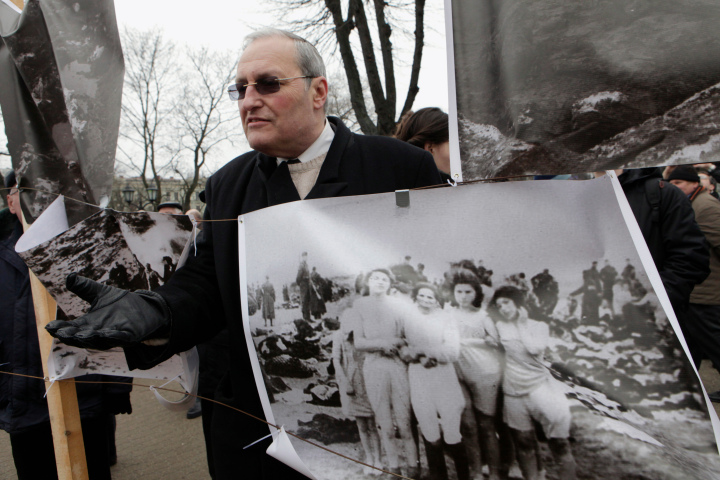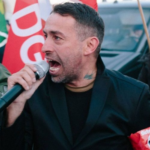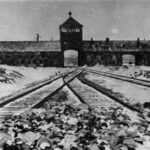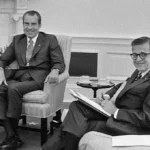Blog Post
The Last Nazi Hunter
By Jonathon Van Maren
While writing his bestselling 1972 novel The Odessa File, Frederick Forsyth traveled to Vienna to meet legendary Nazi-hunter Simon Wiesenthal. He explained the plot to Wiesenthal, noting that he planned to invent a composite character of several Nazi concentration camp commanders as the villain of the story. Wiesenthal waved him off. “Why invent? I have the man for you.” He rummaged about on his office shelves packed with papers, and produced Forsyth’s villain: Eduard Roschmann, the Butcher of Riga.
Two years later, The Odessa File became one of the top-grossing movies of the year. At one point in the film, an actor playing Wiesenthal shows journalist Peter Miller (Jon Voight) a photo of Roschmann, and the camera zooms in on the Nazi’s face. When the film was released worldwide, this scene—and Forsyth’s conversation with Wiesenthal—had an extraordinary unintended effect.
“There was an Argentine sitting in a little town 200 miles south of Buenos Aires watching the film,” Forsyth recounted in the 2006 documentary I Have Never Forgotten You: The Life and Legacy of Simon Wiesenthal. “He thought suddenly: That man lives down the street from me! That is him! He went and denounced him. The local magistrate had him arrested. Buenos Aires informed the German Embassy; the German Embassy said they wanted an extradition warrant. [Roschmann] panicked and ran for the safety of Paraguay. He was crossing the Paraguay River when he suffered a massive and terminal heart attack.” He died without regaining consciousness.
The 75-year history of Nazi-hunting is packed with hard-to-believe stories like this, and as the last Nazis exchange time for eternity, the relentless quest to bring the perpetrators of the 20th century’s greatest crimes to justice is coming to an end. Efraim Zuroff, the last of the independent Nazi-hunters, remembers hearing about Adolf Eichmann’s capture as a boy. “My mother, who was generally a calm person, was very excited when the trial opened in Jerusalem,” he told me. “She sat me down in front of the TV and said Efraim, you’ve got to see this. Israel caught one of the biggest Nazis and they’re putting him on trial. It made an impression on me.”
Zuroff knew Simon Wiesenthal personally, and when I asked what Wiesenthal was like, he laughed and repeated the question before answering. “Very good sense of humor. Very dedicated. And a big ego.” Wiesenthal died in 2005 at the age of 96 after helping track down over 1,000 Nazi war criminals—72-year-old Zuroff is still on the hunt. “I’m the only Jew in the world who prays for the good health of Nazis,” he joked to one interviewer. According to his own estimation, the part-detective, part-academic (Zuroff has a PhD in Holocaust studies) has submitted the names of over 3,000 suspected Nazi war criminals to twenty countries.
Zuroff’s research has produced four books on the Holocaust; he has run the Jerusalem office of the Simon Wiesenthal Center since 1986; and in 2008 he was nominated for the Nobel Peace Prize for his work tracking Nazis. Named after a great-uncle who was murdered in Lithuania during the war, Zuroff is passionate about his work—even now, when Nazi war criminals are harder and harder to find.
Back in 2014, I spoke with Zuroff about Operation Last Chance for the Times of Israel. Operation Last Chance was a push to expose and prosecute remaining war criminals, and a 25,000-euro reward was offered for those who could identify former members of the Einsatzgruppen death squads. “We did not get any tips,” he told me. “We decided to be more proactive and started checking the lists of Einsatzgruppen that we had. In September of 2014, I sent the first list to Interior Minister Thomas de Maiziere and the justice minister Heiko Maas. It was a list of those born 1920 or later who might still be alive.”
“I can’t say the renewal of Operation Last Chance resulted in any prosecutions, but we did find suspects, and every time that information is brought to the public, people who know what they did start worrying,” he told me last year. “I have to say, the fact that the Germans have not brought a single case of an Einsatzgruppen member [after Operation Last Chance] is simply incomprehensible to me.”
There have, however, been five recent trials of elderly concentration camp guards; from Sobibor, Auschwitz, and Stutthof. For Zuroff, the trials are the point—they are an antidote to Holocaust denial, putting the crimes of the Shoah on public record once again. “From April 1, 2009, until today, there have been 24 legal decisions against Nazi war criminals,” he told me. “At least 24 decisions. Some of these cases were tried in absentia in Italy, of Germans who committed atrocities against Italian civilians.”
Many Nazis have been exposed after Zuroff received unlikely tips. One “crazy story,” he told me, involved a Scottish fellow with a Hungarian girlfriend who met an elderly man at a Hungarian event. This man bragged about being involved in the deportations of Jews to Auschwitz. The Scottish boyfriend sent an email to Zuroff, and an investigation was launched. Through that investigation, a prominent Nazi war criminal who was involved in the deportation of 14,000 Jews in June of 1944 and in regular contact with the elderly Hungarian who bragged about his own involvement was brought to justice.
Many tips, however, are hilariously useless. One was a German fellow who wrote to Zuroff that forty years ago, he’d been backpacking somewhere in Peru, in a place he didn’t remember, and he met “The German.” That was the entirety of the details he provided. “The only reason people write these emails is to unburden their conscience,” Zuroff snorted. “They could have said something forty years ago.”
Another was call from America was a typical tip. “Is this the Simon Wiesenthal Center? Yes. Are you still hunting Nazis? Yes. In some cases: Are you still offering money? Yes. Well, last week I had this terrible fight with my 92-year-old German neighbor who must be a Nazi war criminal,” Zuroff laughed. “It would be one thing if they met a guy in a bar who was drunk and said he’d been in the SS and he’d shot Jews. These guys they tell me about, it’s just that they’re German and might be assholes.”
I asked Zuroff what the highlight of his career has been, and his answer was rambling. He started with the Simon Wiesenthal Center after discovering that immigration files could give him the destinations of thousands of Nazi war criminals. After that revelation, he set to work “to try and convince the Anglo-Saxon countries that hadn’t made their minds up yet as to whether they should take legal action against Nazis to do so. We helped convince Canada in ’87, Australia in ’89, and England in ’91 to pass laws to enable prosecution, and the way we did it was by flooding them with the names of suspects, all of which I found by using the method of cross-referencing the files of the international tracing service with information we had on criminals.”
As for which Nazi war criminal he most relished catching? “Dinko Sakic, no question.” Sakic was a Croatian Ustaše official who commanded the Jasenovac concentration camp—“the Auschwitz of the Balkans”—and fled to Argentina after the war.
“At least 100,000 people were murdered there,” Zuroff told me. “Jews, Gypsies, and anti-fascist Croatians. In the most horrible ways imaginable. No gas chambers; no gas vans. Single, individual murders. Rifles. Pistols. Grenades. Knives. Daggers. Swords. You name it. They tried to do it in the most disgusting, painful ways imaginable. He was totally unrepentant. We exposed him in Argentina and got him extradited to Croatia. He was given the maximum sentence, died in prison, and he asked to be buried in his Ustaše uniform. At his funeral, the Dominican Catholic priest who gave the eulogy said the following: It’s true that Dinko Sakic did not observe all the ten commandments. But he was a model for Croatia.”
“This is what we’re up against. But the trial was effective. It’s about the trials. A trial is more effective than any history book.”
Zuroff is not quite finished yet. Zuroff still puts out calls on social media asking for tips; he goes on the radio (like he did recently in Johannesburg) when he suspects someone might have information; he tweets out specific details about war crimes, hoping someone alive remembers what happened and can help him identify a culprit. It’s not impossible that more will be found. As the recent documentary Final Account revealed, there are plenty of elderly SS members and concentration camp guards grappling with what they did while the Third Reich was still conquering the world.
“We are almost finished,” Zuroff said recently. But not yet. The Nazis put six million Jewish people in their graves, and Efraim Zuroff will hound them until the last criminal has been laid into his.








